You’ve got your own streaming service or video membership with top-notch content, but how do you take it a step further and launch CTV apps? Surely it’s got to be complex right? Well, it doesn’t have to be! What if I told you there’s a way to build CTV apps without needing any technical expertise at all?.
Stick around for a simple 6-step guide from zero to launch, and why CTV apps are a must for video-on-demand businesses wanting to grow and compete with the big names on your customer’s TV screens.
Why content creators like you need CTV apps
To be clear, when we say ‘CTV apps’ we’re talking about connected TV apps. These are the apps you use on your TV to stream content, which includes Roku, Apple TV, Fire TV, Android TV, Samsung, and so on… Basically, any app you would use on a smart TV or a plug-in streaming device (like an Amazon Firestick, Roku stick, or games console).
If you’re launching a streaming service, offering TV apps is an essential part of the user experience. Let’s run through 4 ways it benefits you as the video creator:
CTV usage is booming – More people stream content on smart TVs (or plug-in streaming devices) than ever. Our internal data shows that:
- Nearly 50% of TV app viewers watch content solely on TV apps. Which is an opportunity to reach a wider audience.
- Every week members spend an average of 102 minutes watching content on apps vs 82 minutes a week streaming content without apps.
- Roku is the most popular TV app, making up 80% of watch time from TV apps.
CTV apps let you meet your audience where they’re at – from the comfort of their sofas and big screens.
Increased monetization opportunities – TV apps give users more flexibility in how they can watch your content, which means more opportunities for you to offer different monetization options to make the most of your content. If you have a subscription-based model (SVOD), this could be an opportunity to offer selected content on a per-per-view (TVOD) basis as an add-on or alternative option. After all, binge-watching a series is much more comfortable from your TV screen.
Generate more recurring revenue – Some of our top-earning creators have achieved success by offering both mobile and TV apps. Both Abundance+ & Studio Bloom launched 6 mobile & TV apps, and over 76% of watch time comes from their apps. These memberships both have 5,000+ subscribers and earn over 1M in annual revenue.
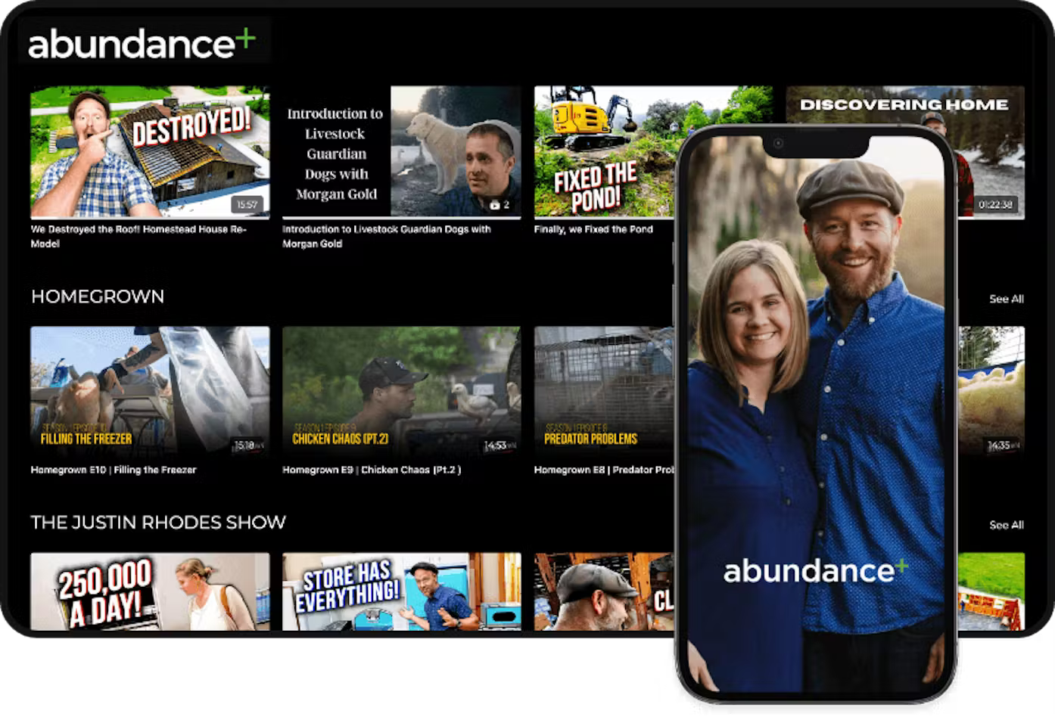
We went from $30,000 a month to over $130,000+ a month with the Abundance+ launch with Uscreen. When I look at that number, I am absolutely blown away and honored because that means I’m bringing a lot of service into the world. That’s the measure of success.
Justin Rhodes, Founder of Abundance+
Improve user experience –Let’s face it, streaming content on your TV is a much better experience than relying on a web browser for access. Having your dedicated TV app shows your subscribers that you care about offering them the best user experience right there in their living rooms. Plus, apps are a proven way to increase retention.
In our experience:
- Creators with their apps see a 2x increase in monthly recurring revenue.
- Uscreen customers who offer mobile & TV apps have 15% more retention than those who don’t.
- Media & entertainment-focused creators see an average of 70% member growth in the first month of launching an app.
Take the hugely popular yoga and wellness membership Find What Feels Good for example. 65% of their content is streamed through apps, which has positively impacted their business:
Since we updated to the native Uscreen apps, we’ve seen our churn dramatically decrease. It’s a cohesive experience now, and it inspires confidence in our community to stay with us. Plus, having our own app feels personal and intimate because it’s something our members can take with them.
Chris Sharpe, Co-Founder & COO, Find What Feels Good
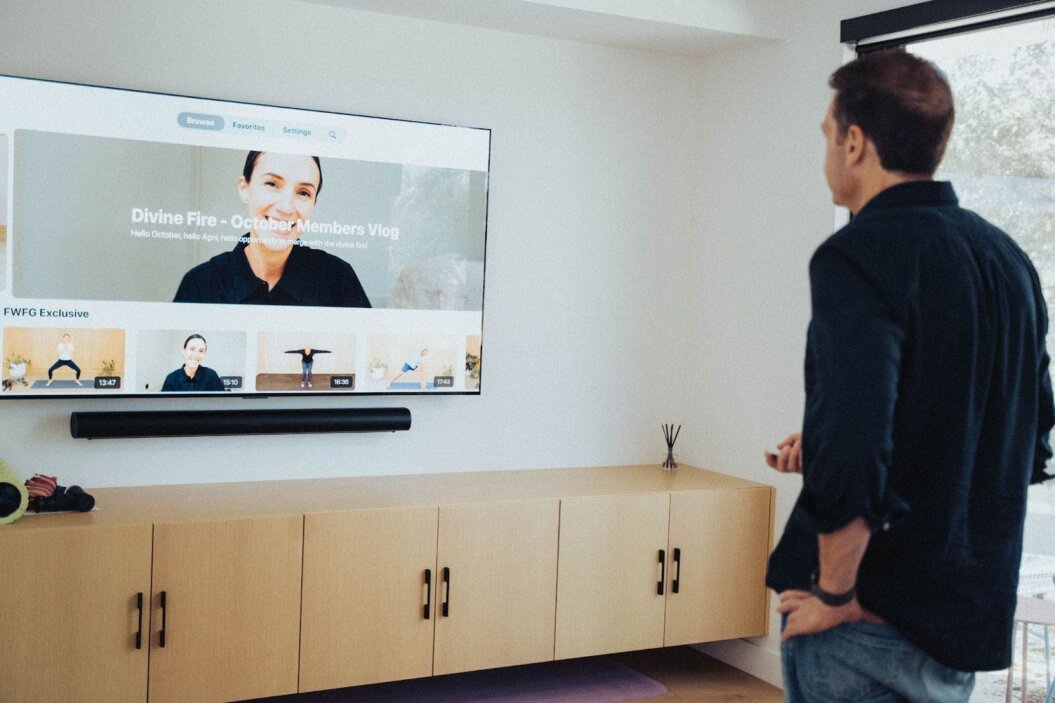
2 ways to build CTV apps
The 2 main ways to build CTV apps are to lease them through an OTT platform or hire a developer to create them from scratch. The alternative would be to build them yourself if you’re an app developer (this is out of the scope of this article, so if this is you, you’ll want to look for a more in-depth technical guide).
The easiest way: Leasing an OTT app platform
Using an OTT platform to build your CTV apps is easier because they do all the technical work for you in exchange for a monthly fee. All you need to do is sign up and order your apps, there are no complicated plans or design work to execute.
What is an OTT app platform?
An OTT platform gives you the tools to create an ‘over-the-top’ streaming service. This means a range of video content that users can pay to stream online in a range of ways, and include options for web, mobile, and TV apps. It’s a way of distributing your content everywhere and engaging your audience wherever they are.
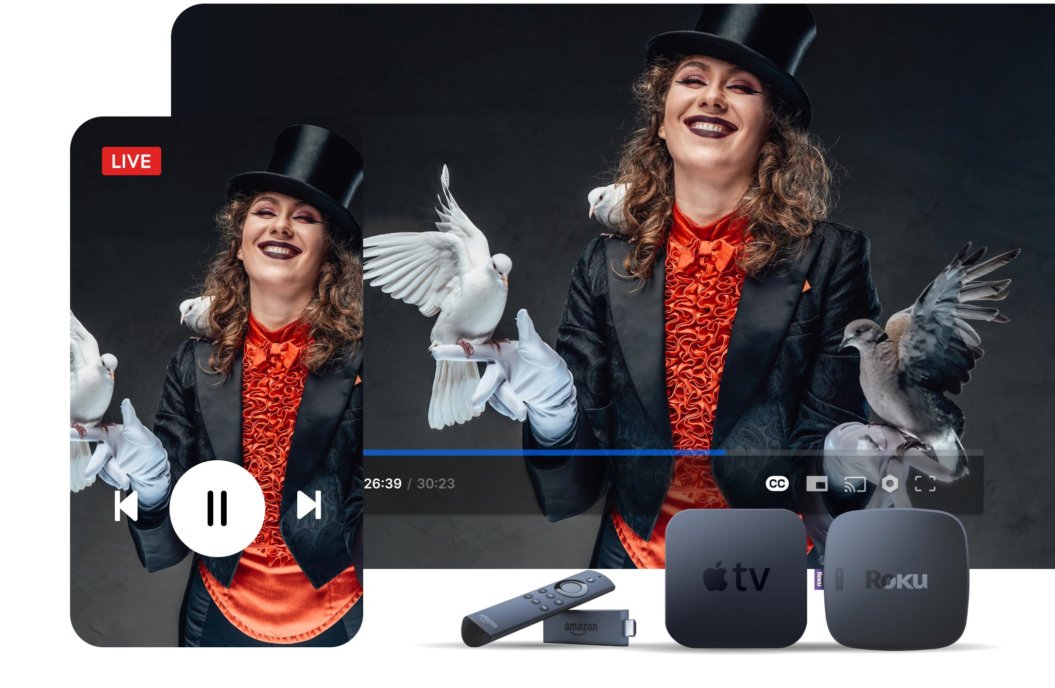
OTT platforms, like Uscreen, provide you with a website builder, marketing tools, technical support, and access to features like live streaming, community, a Netflix-style video catalog, and video monetization options.
They’re designed for creators and media businesses who want to create OTT apps without technical skills or coding expertise, and you can get started in minutes using pre-built templates and intuitive content management.
How it works:
When you use an OTT platform, you’re technically leasing the apps through that platform. Think of it as the difference between renting a fully serviced home which comes with everything you could need, or building one from scratch and having to outsource and pay for the work and maintenance needed.
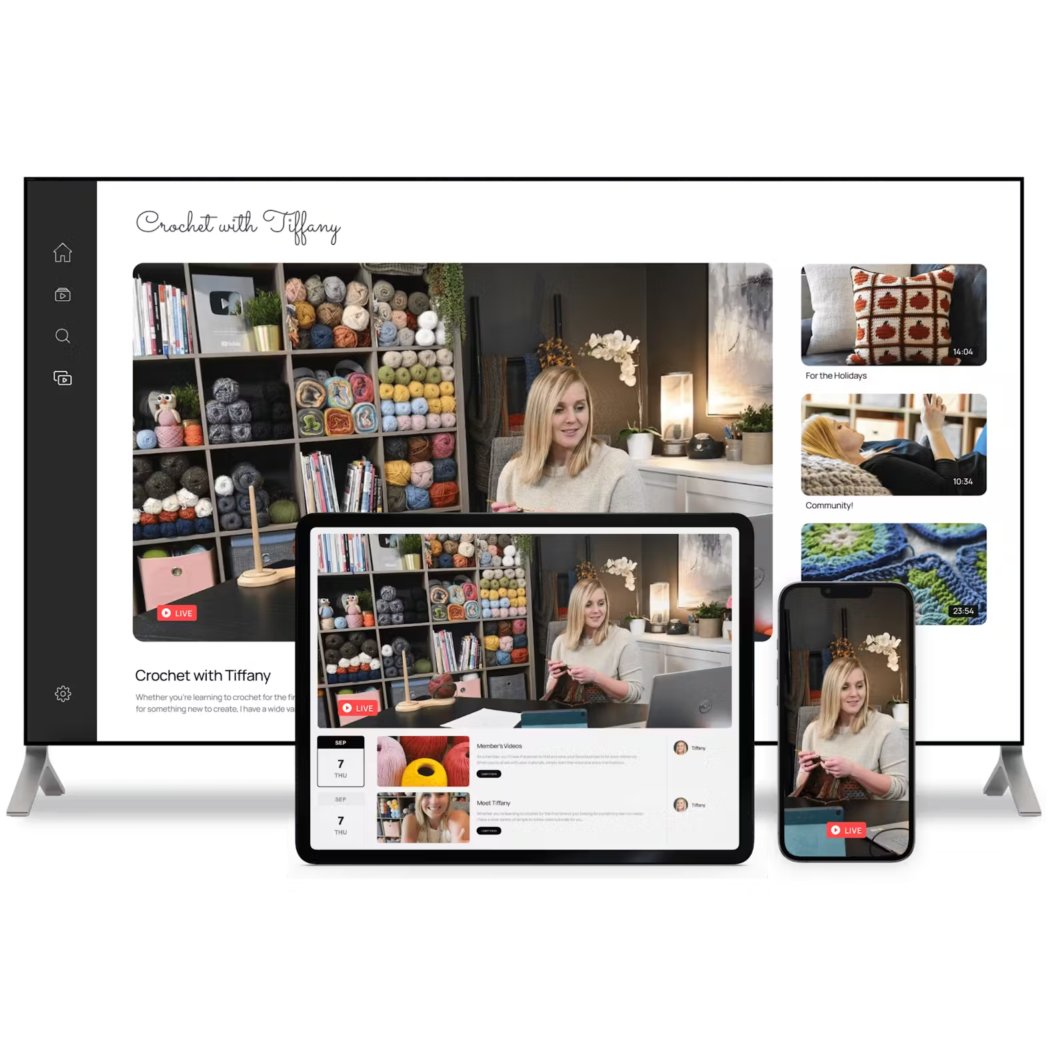
The cheat sheet version of the process looks like this:
- Choose an OTT platform.
- Customize your branding & layout.
- Upload content & configure monetization.
- Submit to app stores (most platforms support you through this step).
- Launch & start reaching your audience!
Key benefits of leasing apps through an OTT platform:
✅ No coding required – meaning you can focus on the creative side, and let someone else do the hard stuff.
✅ Lower upfront costs – making it more accessible for creators and smaller businesses, apps aren’t just for the big names.
✅ Faster launch time – your app could be live on your customers’ screens in as little as 30 days!
✅ Automatic updates & maintenance – you won’t need to worry about how to maintain your app, because the app team will handle all that for you.
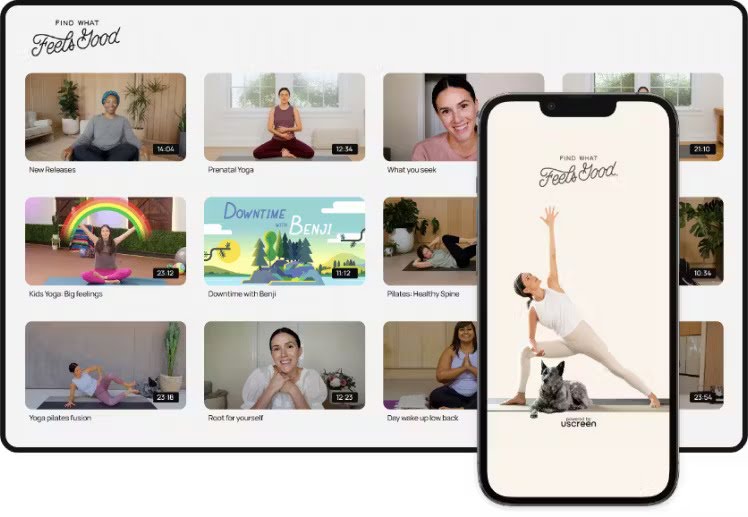
We were stitching together a ton of different platforms, and we’re not a technical team—we’re a creative organization, so that wasn’t our skill set. Consolidating everything on Uscreen was night and day for us, operationally and creatively.
Chris Sharpe, Co-Founder & COO, Find What Feels Good
Alternative option: Hiring a developer
The second option is to hire an app developer to build your CTV apps. The main benefit of this approach is having full control and ownership over your app, which is beneficial if you need a unique set of features and have a specific vision for your app’s layout and functionality.
When does hiring a developer make sense?
- You need a fully custom app with unique features – a good example here would be Netflix and its algorithm which recommends content based on what you’ve watched or liked.
- You want 100% control over monetization – while you still have plenty of control over your monetization through most platforms, they might not support every monetization model you want to take advantage of.
- You plan to scale into a larger platform – big companies who want to create a large-scale app might feel limited by what an OTT platform can offer. For example, you’ll usually have a set allowance for bandwidth and video storage which can quickly run out, although custom plans are available to accommodate these needs.
Challenges of custom development
- Expensive – Costs start at $40,000+ in comparison to the fixed monthly cost of leasing an app (which starts at $499 per month with Uscreen).
- Time-consuming – Takes 3–6+ months vs 30- 45 days with a platform.
- Ongoing maintenance costs – All apps require updates & bug fixes. And if you’re building apps for multiple providers (like Roku, Apple, Android, and Amazon) then these will need to be addressed separately. Developers will charge additional fees for maintenance, while this is included in your fees with an OTT platform.
How to find a developer or agency
If the developer route is for you, look for an app developer that specializes in TV apps, with experience in the various platforms you want to build for (like Roku, Apple, Fire TV, and Android). All these providers run on different coding languages, so you’ll need a developer with the right level of experience.
Looking for an app developer agency is a good way to go to ensure you get all your needs met, and will offer a more rounded service, with the potential for ongoing support but this will be a much bigger expense than hiring an individual developer (essentially the difference between hiring a freelancer vs a business).
Either way, look for someone who can provide examples of CTV apps they’ve built with client testimonials to back that up.
Build your CTV apps in 6 steps (the easy way!)
For the rest of this article, we’re going to be focusing on how to build CTV apps with an OTT platform, because that’s our area of expertise. Let’s start with how to choose the right platform 👇
1. Choose the right OTT platform
The key to choosing the right platform is being clear on what your goals are. Which TV app platforms do you want to be on? Do you have a large, existing content library? Which features are essential for your streaming service? And, crucially, what’s your budget? These are some starting points to nail down what your needs are.
The more specific you can be, the better. This will help you narrow down your choices based on whether or not they meet your needs, rather than being overwhelmed by endless options.
We’ve rounded up the top OTT platforms for 2025 below to help you get started.
| Platform | Best for | Cost | TV apps offered |
|---|---|---|---|
| Uscreen | Creators and businesses with an existing audience looking to launch premium OTT apps. | App essentials plan from $449 per month + per subscriber fee. | Roku, Fire TV, Samsung, Apple TV and Android TV. |
| Vimeo OTT | Filmmakers and media companies focused purely on high-quality video delivery. | Enterprise plan for apps: contact sales for a custom quote | Roku, Fire TV, Samsung, Apple TV and Android TV. |
| Muvi | Enterprises and media companies looking for a fully customizable, white-label OTT platform with extensive features and integrations. | Contact sales for pricing | Roku, Fire TV, Apple TV, Android TV, VEWD, Tizen, Playstation, Xbox |
| Kaltura | Large organizations and educational institutions needing an open-source OTT solution with advanced customization. | Contact sales for pricing | Apple TV, Android TV |
| Brightcove | Businesses looking for a tailor-made OTT & video hosting package. | Custom pricing | Roku, Fire TV, Samsung, Apple TV and Android TV |
| Zype | Businesses and creators looking for an OTT platform with strong API capabilities. | From $500/month | Roku, Fire TV, Samsung, Apple TV and Android TV |
2. Pick your monetization model
A key part of building your CTV apps is deciding how to monetize them. Look out for OTT platforms that offer flexible monetization options so you can pick and choose a range of subscription tiers. These are the most common monetization models users expect to see on TV apps:
- SVOD: Subscription-video-on-demand. Charge a monthly (or annual/quarterly) fee in exchange for unlimited access to your content.
- TVOD: Transactional-video-on-demand. Having content available to purchase on a pay-per-view basis.
- AVOD: Advertising-video-on-demand. Users can watch your videos for free and are served with ads, and you gain revenue based on the views and engagements with these ads (think YouTube).
- Hybrid: Offering a mixture of monetization options. For example, Netflix offers an ad-supported option as their lowest pricing tier. Or some creators offer both SVOD as the primary model with options to purchase one-off video collections, like Fittest Core’s workout programs:
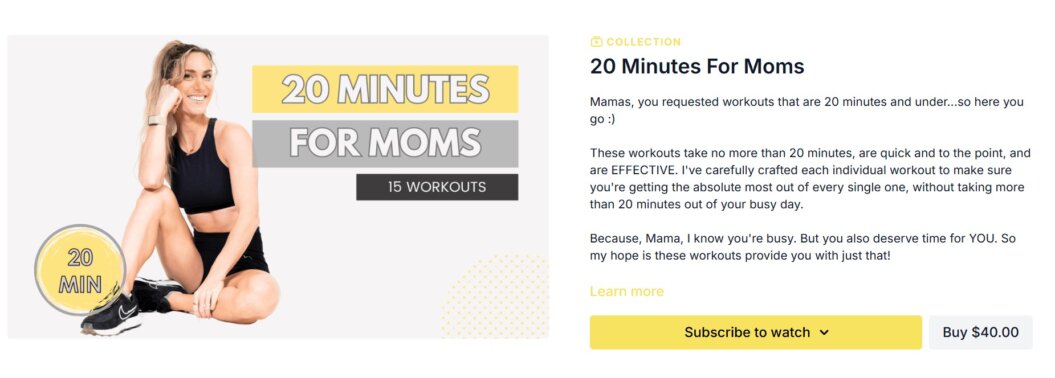
3. Submit your app assets
You’ll need to provide your branding assets to your chosen platform so they can create your CTV apps, that look and feel like your brand. Your platform will advise you on what you need to provide, and it will likely include:
- Branding imagery and logo
- Your brand colours
- Icon
- App name
- App descriptions
💡Top tip: Start thinking about how your app will look in the TV app stores. You’ll need imagery to submit here too, to showcase your app and make it as eye-catching as possible, plus great copy to describe your app and encourage users to download it. These are all essential elements of app store optimization (ASO).
Check out how Ombe Surf Training’s app listing looks in the app store:
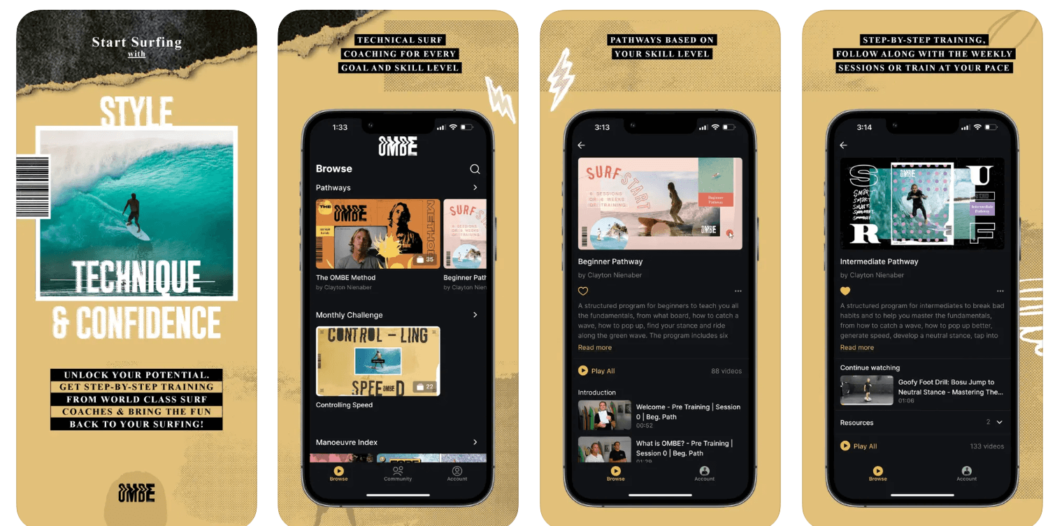
This is their mobile app, but you can apply the principles here to your TV apps: eye-catching, branded imagery and a clear vision of what users will experience by downloading the app.
4. Upload and organize your content
Next up, you’ll prepare your video catalog so that your content is ready to go, and it will be pulled directly into the app during the build.
When you sign up with Uscreen you’ll get a website to host your Netflix-style video catalog. It’s a simple web builder that you create with templates available, so again, no technical whizz skills are needed to get it up and running. Like the below example from NextUp Comedy:

Even if your focus is on releasing content on your CTV apps, it’s important to have an accessible video catalog that your users can stream in multiple ways; through the web, mobile, and TV apps.
If you already have a large library of video content, organizing this into intuitive categories for your audience is important to make it user-friendly and easy to browse. Kylie Julien, our Senior Video Production Specialist here at Uscreen, shares her advice on where to start:
Before you jump into tagging and sorting, study what others in your industry do to organize their content. It will give you a clue as to what your audience will be expecting. (If you don’t know anyone in your niche, check out the Uscreen examples page.)
I’d also recommend keeping your organization simple in the beginning, and then getting feedback from early customers.
Kylie Julien, Senior Video Production Specialist at Uscreen
💡Pro tip: Don’t forget about your video descriptions. These are important elements to keep your paying users interested and engaged in your content, drawing them in to watch more. The more engaged they are with your videos, the more likely they are to retain their subscription, leaving you with more money coming in each month.
Kylie’s advice here is:
- Make sure your catalog is searchable by adding keywords to your description and tags.
- Write clear titles. Inside your VOD website, you aren’t competing in an algorithm, so titles can be more straightforward. (Which can also help with searching!)
Switching to Uscreen from another platform? Our migration team is here to handle everything for you.
5. Submit your apps to the app stores
At Uscreen, we handle submitting your apps to the app stores for approval. It’s important to be aware that this is the stage where we have no control over the timeline, as it’s down to the individual app stores to review and approve your apps – and they all have different timeframes for doing this.
We’ve outlined the average timelines below, but this can vary depending on individual apps and whether an app gets rejected and needs adjusting before resubmitting (again, this is all handled by the Uscreen team so all you do at this stage is sit back and wait!)
| App store | Average approval timeline |
|---|---|
| IOS (Apple) | 24-48 hours |
| Google Play (Android) | 3-7 days |
| Amazon Fire TV | 3-5 days |
| Roku | 3-5 days |
| Samsung | 3-5 days |
While you wait for approval, why not work on your launch strategy to get eyes on your app once it’s live?👇
6. Launch and promote
Planning a launch strategy and continuous promotion for your streaming service is the key to success. Create a buzz in the run-up to your app going live so that your followers know it’s coming.
Social media guru Milou Pietersz shares her advice on creating a plan and sticking to it, and getting your followers onto an email list so you can reach out to them directly about your app’s progress:
One mistake that a lot of creators make is not building out a proper launch, but waiting until their membership is live to announce it. Have a plan, be consistent in sticking to it, and share your progress so your audience can be part of the journey.
Milou Pietersz, Content Creator & Founder of Simply Multimedia
💡Pro tip: Speak directly to your audience’s pain points when posting about your streaming service. Who are they, and what are their challenges? What interests and excites them? If followers can see the solution to their problems directly in your messaging, they’re much more likely to convert.
Let’s look at a quick example from Fittest Core’s Instagram, which is screenshot from a reel Macy shared recently:
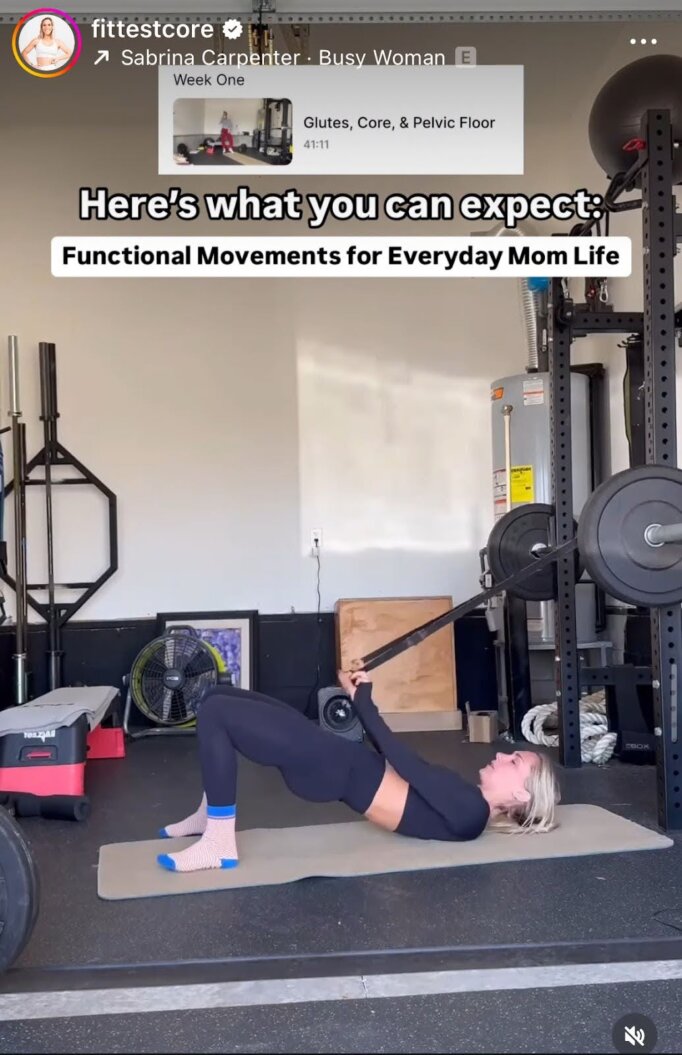
This post tells people exactly what to expect from the Fittest Core program by showing a snippet from the workout.
Check out the wording: ‘functional movements for everyday mom life.’ This tells us who it’s for, but also taps into a deeper common challenge: trying to fit in exercise around a hectic day as a mom. The word ‘functional’ makes it feel accessible and practical, cutting straight to the chase. Even the choice of song here, Sabrina Carpenter’s Busy Woman, is intentional and adds to the vibe.
Most OTT platforms come with built-in marketing tools that you can use to market your apps to your target audience and create tried-and-tested funnels to capture interest and encourage users to sign up.
How much does it cost to build CTV apps?
Whichever route you choose, building CTV apps is an investment in your business. Below we break down the factors involved in creating and maintaining apps, and how these compare between leasing OTT apps through a platform like Uscreen and hiring an app developer.
| Cost factor | Leasing an OTT app | Hiring a developer |
|---|---|---|
| Upfront cost | $500 – $5,000 | $20,000 – $100,000+ |
| Development time | 2-6 weeks | 3-6 months |
| Customization | Pre-built (included) | Full customization (starting from scratch) |
| Maintenance | Included | Extra ($5,000+/yr) |
| App store fees | Included | Requires manual submission & fees |
| Monetization | Included | Custom development needed |
Why leasing CTV apps is the best option for creators
Building multiple TV apps requires a lot of technical knowledge and skills. OTT platforms like Uscreen are building these apps all the time, which means they’re best placed to create an app that users will love and keep coming back to.
Leasing an app is much more accessible for creators. It doesn’t require a huge upfront investment, you’re guaranteed a high-quality result, and you could launch in as little as 45 days. You’ll also have ongoing support from the app team which is included in your monthly fee, so you have a whole team of experts that have your back and help you succeed.
When does it make sense to hire a developer?
Hiring a developer to build your CTV apps is better for large companies with complex needs. If you have the budget, and the ambition to create something bespoke that goes beyond the scope of what an OTT platform can build, then this could be the right choice for you.
Next steps
- Research the best OTT platforms for building your CTV apps. Luckily we’ve done the hard work for you and rounded up the 7 best OTT platforms on the market.
- Set up your content strategy. What do you plan to publish in the next 3, 6, and 12 months ahead?
- Launch & start growing your audience!
Build, launch and manage your membership, all in one place.
CTV apps: Frequently asked questions
CTV stands for Connected TV Apps, which simply means streaming video through your TV using smart TV apps, or plug-in devices like Amazon Fire Stick, Roku, or games consoles.
Netflix is a streaming service that you can access using CTV apps and devices. You can download the Netflix app directly to a smart TV, or onto a streaming device like a firestick.
CTV is a method of streaming video on demand (VOD). You can access VOD services through Connected TV apps on smart TVs and plug-in devices like Roku and Amazon Fire TV.
Apple TV, Android TV, Roku, Fire TV, and Samsung TV are all examples of CTV platforms. You can access a range of TV apps from each of them, like Netflix, Disney Plus, and Prime Video, or from individual creators who have launched their own TV apps.
OTT is the way content is delivered over the internet, whereas CTV refers to the individual devices and platforms you can use to stream video content on your TV screen.

